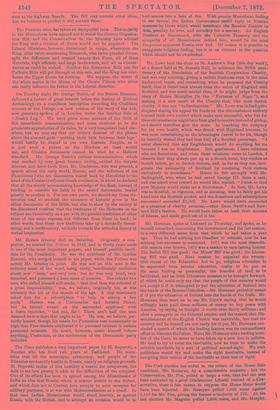On Tuesday night Mr. George Smith, of the British Museum,
delivered a lecture of great interest before the Society of Biblical Archa3ology, on a cuneiform inscription recording the Chaldasan account of the Deluge,—a new version of the story of the Ark, now generally spoken of in London under the familiar title of "Noah's Log." We have given some account of the drift of this remarkable communication, and some cautions as to the premature appreciation of its value, by a very competent hand else- where, but we may say that our critic's distrust of the phrase about the alarmed gods "putting their tails between their legs" would hardly be shared in our own Eastern Empire, as it is just such a phrase as the Hindoos at least would use, and C beide° documents cannot be tried by a Hebrew standard. Mr. George Smith's curious communication, which was marked by very great literary ability, excited the deepest interest, and drew forth from Mr. Gladstone, who was present, a speech about the early world, Homer, and the influence of the Phcenicians (who are themselves traced back by Herodotus to the head of the Persian Gulf) over Greek civilisation, in which he declared that all the slowly accumulating knowledge of the East, instead of tending to unsettle his faith in the sacred documents, tended greatly to confirm it. For our own parts, we should say these dis- coveries tend to establish the existence of historic germs in the oldest documents of the Bible, but also to show by the variety of the discovered versions that the traditions of the Hebrews on the subject are historically on a par with the parallel traditions of other races of the same regions, not different from them in kind ; in other words, that these new traditions take up a decidedly threat- ening, not a confirmatory, attitude towards the orthodox theory of verbal inspiration.


































 Previous page
Previous page